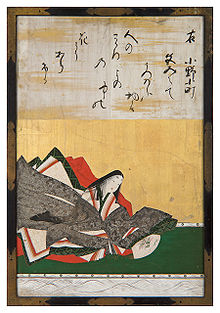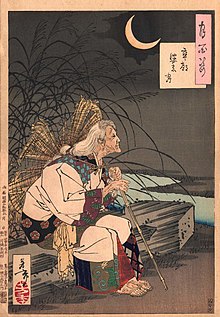Ono no Komachi



Ono no Komachi ( Japanese 小野 小 町 ; * approx. 825; † approx. 900) was a great Japanese poet . Ono is one of the Six Best Waka Poets of the Early Heian Period , as well as the Thirty-Six Immortals of Poetry . She was considered exceptionally beautiful and became a symbol of feminine beauty in Japan .
Life and legend
Ono's birthplace and place of death are not known for certain. Tradition has it that she was born in what is now Akita Prefecture, the daughter of Yoshisada , a district administrator of Dewa . It could be that she lived at the court of Emperor Nimmyo (reign 833-850).
According to a legend about a relationship with the high-ranking courtier Fukakusa no Shosho, Ono had promised him that she would become his lover if he visited her for a hundred nights. Fukakusa no Shosho visited her every night except the last when it was held. In desperation, he fell ill and died. When Ono found out about this, she was overcome with grief.
plant
Ono wrote extremely condensed and complex love poems in waka form. Eighteen of her songs are in the first imperial poetry collection, the Kokin-shū of Emperor Uda . According to Kokin-shū, Ono's style is characterized by “naivety in the old sense”. The translation of Ono's works is extremely difficult, since she used words with multiple meanings in a virtuoso manner, so that her poems have completely different meanings depending on what word meaning is assumed. In order to reproduce a poem completely, several translations would have to be given. The following example comes from the Kokin-shū:
“The lovely color of
the flowers is gone,
destroyed by the falling rain.
Meanwhile, while I spent
the days uselessly, I let my gaze
wander into the void. "
The second imperial poetry collection , the Gosenshū, contains four poems by Onos. Most of her works are about fear, loneliness and hot-blooded love. Dreams are also a recurring motif. She uses flowers and petals several times as metaphors for transience.
effect
Ono appears frequently in Japanese literature , for example in the two Nō pieces translated by Donald Keene : Sotoba Komachi ( 卒 都 婆 小 町 ), Sekidera Komachi ( 関 寺 小 町 ). Other pieces are Sōshi-arai Komachi ( 草紙 洗 小 町 ), Kayoi Komachi ( 通 小 町 ) and Ōmu Komachi ( 鸚鵡 小 町 ). These works look at Ono's poems and love stories, but also depict Ono as an old, lonely woman who lives as a beggar, abandoned by her lovers, and yet at the same time is revered by young lovers of her poems. These legends are influenced by Buddhist thought.
Fujiwara no Teika uses one of her 31-syllable poems as an introduction to his anthology of waka poems Hyakunin Isshu, made famous through the card game Uta-Garuta .
In her honor, the Akita-Shinkansen high-speed rail line was nicknamed Komachi . The Akita Komachi rice variety and a limited edition Olympus E-420 camera were also named after her .
The British-Australian composer Vivienne Olive named the chamber music piece … is the flower of the heart of man… from 1985 for bass flute after a poem by Ono no Komachi.
Ono is the namesake for the modern one-woman piece Call Me Komachi , written by Christie Nieman. Call Me Komachi was successfully performed with actress Kaori Hamamoto in Australia from 2003 to 2006. The piece compares the life of traditional geishas with enjokōsai , in which Japanese schoolgirls go out with older men and accept gifts in return.
gallery
Ono no Komachi drawn by Kikuchi Yōsai
swell
- Jane Hirshfield, Mariko Aratani: The Ink Dark Moon. Love Poems by Ono no Komachi and Izumi Shikibu, Women of the Ancient Court of Japan . Vintage Books, New York 1990, ISBN 0-679-72958-5 .
Web links
Individual evidence
- ↑ a b Kenneth Rexroth, Ikuko Atsumi: Woman poets of Japan . New Directions Pub. Corp., New York 1977, ISBN 0-8112-0820-6 .
- ↑ "Her poems begin the extreme verbal complexity which distinguishes the poetry of the Kokinshū Anthology from the presentational immediacy of the Man'yōshū ." Rexroth (1977: 141)
- ↑ Andrea Germer , Andreas Moerke (Ed.): Grenzzüge . (De) construction of collective identities in Japan . Volume 16, Iudicum Verlag, Munich 2004, ISBN 3-89129-379-8 , p. 263
- ^ Donald Keene: Twenty Plays of the Nō Theater . Columbia University Press, New York 1970, ISBN 0-231-03454-7 .
- ^ Sex, slavery and shopping The Age, 2003
| personal data | |
|---|---|
| SURNAME | Ono no Komachi |
| ALTERNATIVE NAMES | 小野 小 町 (Japanese) |
| BRIEF DESCRIPTION | Japanese poet |
| DATE OF BIRTH | around 825 |
| DATE OF DEATH | around 900 |
